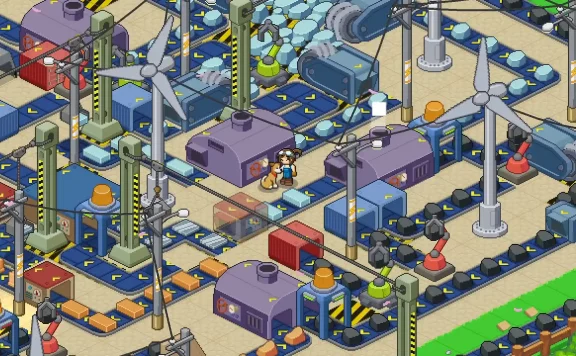Little Rocket Lab is going to be your new cosy obsession, I’m calling it now. To reference a discredited scientific theory, it’s a game that’s designed to appeal to both hemispheres of your brain perfectly. Your “left brain” is going to love the cute town of St Ambrose and decorating your homestead. Your “right brain”, though, is going to lose hours to the pursuit of logistical perfection; designing and redesigning automated production lines to maximise your throughput and deliver materials and components to every corner of the town. It’s a genius concept and bringing those two aspects together will allow you to express your creativity by refining and optimising your assembly lines.
As with most of these cosy, farming-adjacent games we’re treated to a bit of backstory at the start. It’s nothing particularly unique, with Morgan enjoying an idyllic childhood in St Ambrose until her mum passes away and she has to leave. The game picks up ten years later as she returns to her aunties home, ready to pick up where she left off and continue tinkering with robots, electronics and yes, even rockets.

It’s a nice setup, and introduces you to a colourful cast of human and robotic characters that grows throughout the game. This charm is amplified by the cutesy visuals, featuring little emoji speech bubbles that pop up above characters heads during dialogue. An upbeat soundtrack adds to this, creating something that feels like it was made to be played while curled up on the sofa, preferably on a handheld. The visuals do a great job of conveying everything you build and produce clearly too, which is handy as the screen can very quickly become cluttered.
The aim of the game is essentially to build or generate resources that you can funnel into various projects around town, whether that’s supplying them to the museum so they can research new tools for you, or into your auntie’s rocket silo to carry out the project you started all those years ago before you left. It’s an incredibly engaging hook, and like the best games in the genre, it’s easy to keep telling yourself “just one more day and then I’ll go to bed”. It helps that the game respects your time too: you’re not rationing your energy bar and a full day is long enough that you can accomplish a lot, especially if you’re organised.

I appreciate that respect, and the game’s generous with its systems too. I’m not the most organised person when it comes to planning out conveyor belts and systems, but you’ve got loads of space to play with and if you misplace something then it’s a quick fix to just delete it and move it. There are some really nice little touches that I didn’t notice until hours into the game, such as when I placed a long conveyor belt only to realise it was moving in the wrong direction. Rather than deleting it block by block and replacing it, I was able to just place a new one over the top in the right direction without impacting my resources. It feels really streamlined and encourages you to experiment with different tools and layouts to generate the components you need as quickly as possible.
It’s a good thing too: as the game goes on you’ll be asked for hundreds and hundreds of components and resources to be funnelled into your projects, so the systems you build to deliver them will naturally become more complex. You’ll have drills mining natural resources, which run directly into level 2 furnaces that take the coal plus whatever ore you’re smelting and deliver them to assemblers that build basic components, all funnelling into more complex machinery. You’ll be creating higher and higher tier components using assemblers that take multiple items to create, using buffer components that optimise the throughput of your machinery, and creating energy systems that power your ever-growing al fresco factory. I lost track of the number of times I decided I needed a component, such as a large motor, and the assembly line I mapped out in my head quickly doubled and tripled in size as I remembered how many different machines I’d need to make them.

There’s very little to complain about in the game, really. Yes, some of the requests for materials can feel a bit overwhelming at first but the solutions are never difficult. It’s about making sure you’re being as efficient as possible delivering the materials, and I had multiple occasions where I was doing the right thing, I just wasn’t doing it well enough and so I had to rethink my strategy to speed things up. I enjoyed Morgan’s story, and while the cast of characters was fun, there weren’t many that I grew to love as much as her loving aunt or Toastie, the giant, rideable robotic toaster.
Little Rocket Lab is a lovely game, and an essential pick for fans of cosy games, but its systems are deep enough that I think the Factorio and Satisfactory players out there will still get a kick out of it. It respects the players time and empowers you to get creative with your systems, and it all comes together to make a game that’s very, very difficult to put down.


